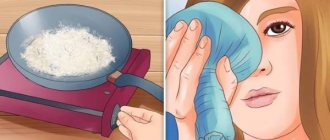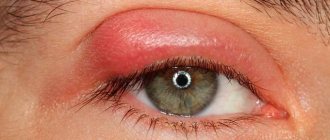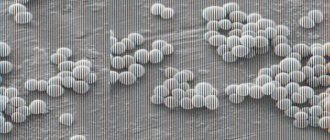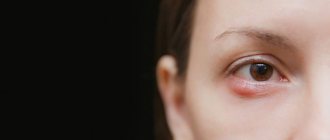Ophthalmologist, Laser ophthalmic surgery
Karapetyan
Arevik Samvelovna
6 years experience
Ophthalmologist
Make an appointment
Acute purulent inflammation in the hair follicle of the eyelash or in the sebaceous gland is called “barley” because of its characteristic round shape, reminiscent of grain. The external harmlessness of this phenomenon is deceptive: it clearly indicates a decrease in the protective properties of the immune system and requires careful treatment to prevent relapses and possible complications.
Causes of stye on the eye
Staphylococci, which prefer to settle on human skin and hair, do not manifest themselves in any way with strong immunity. Their intensive reproduction is triggered by a decrease in the protective properties of the body, its hypothermia, severe illnesses and hypovitaminosis, and the consequences of helminthic infestation. Penetrating into the structure of the hair follicle, streptococci cause inflammation and suppuration as a reaction to a pathogenic microorganism. This is the main cause of stye on the eye in patients of all ages. With an unbalanced diet, increased physical activity or stressful situations, the disease can occur in the form of several or multiple suppurations on the eyelids or mucous membranes. Also among the factors contributing to the appearance of stye on the eye is the habit of touching the eyelids with dirty hands, a large amount of dust indoors or outdoors.
The risk group for the likelihood of the appearance of barley includes:
- patients with reduced immunity;
- persons with diseases of the endocrine system;
- patients with gastrointestinal pathologies;
- persons whose professional activities involve working outdoors or in premises with difficult climatic or unsanitary conditions;
- patients who have suffered inflammatory diseases of the eyes and eyelids, as well as those who have not completed the prescribed course of treatment.
Folk recipes
Hordeolum responds well to treatment using traditional medicine. To speed up the maturation of the sore, it can be warmed with salt. To do this, heat regular table salt in a frying pan, then transfer it to a fabric bag and apply it to the sore spot. Keep until completely cool.
This method can only be used when the barley is not yet ripe. As soon as a purulent tip appears, the procedure is stopped. Before applying the bag to your eyes, you need to make sure that the salt is not very hot, otherwise you can get burned.
To speed up recovery, you can use the following folk recipes.
Burdock compress
You will need the rhizome of an adult plant. It is thoroughly washed, cleaned and poured with boiling water for 30 minutes. After this, the root is crushed using a blender. The resulting pulp is wrapped in gauze and applied to the barley for 20-30 minutes. This procedure promotes the rapid maturation of hordeolum and relieves inflammation.
Dill compresses
10 grams of dill seed are crushed using a coffee grinder, poured with a liter of boiling water and brought to a boil on the stove. Remove from heat, cool. A cotton pad is generously moistened in the resulting decoction and applied to the eyes for 20 minutes.
Plantain leaves
This natural healer has excellent bactericidal properties. All you need to do is pick a few leaves of plantain, wash them thoroughly, pour boiling water over them, mash a little and apply to the sore eyelid for 5 minutes. After this, replace the sheet with a fresh one. The procedure takes at least 15 minutes.
Symptoms of stye on the eye
Suppuration of the eyelid makes itself felt by a feeling of heaviness, swelling and inflammation along the eyelash line. The area becomes painful, the temperature of the skin of the eyelids rises. The line of edema has clear boundaries; signs of hyperemia are noticeable on the conjunctiva - redness and inflammation. Within 2-3 days from the moment the barley develops, a purulent head forms on its surface, the contents of which are dead cells of the hair follicle.
With internal barley, the pathology is localized in the area under the eyelid - in the so-called meibomian gland, which makes the disease almost invisible. The inflammatory process is indicated by the characteristic symptoms of stye - thickening and soreness of the affected eyelid. The danger of such a disease is the development of chalazion - inflammation of the cartilage around the meibomian gland, which significantly delays the healing process and forces the patient to undergo regular examinations by an ophthalmologist.
In severe cases, with barley localized inside the sebaceous gland, signs of general intoxication are observed - headache and muscle pain, fever, swollen lymph nodes. Self-medication in this case is strictly contraindicated, and the patient should immediately seek medical help.
What to do and how to treat?
Medicines
The sooner a person is treated, the faster the stye goes away. For pathology in the eye area, you can use medications that speed up the healing process and eliminate unpleasant symptoms. To avoid the spread of a purulent-inflammatory focus, use calendula-based tinctures, medical alcohol or iodine solution. In order for the pathological process to pass faster, all manipulations must be performed with previously washed hands, using a sterile cotton pad or swab. For barley, it is necessary to use medications with antibacterial and anti-inflammatory effects. Effective medications that speed up the healing process are presented in the table:
| Form of production | Name |
| Ointment | Tetracycline |
| Hydrocortisone | |
| Erythromycin | |
| Drops | "Sulfacyl sodium" |
| "Sofradex" | |
| "Tobramycin" | |
| "Levomecitin" | |
| "Albucid" | |
| "Penicillin" |
When treating the lower eyelid with ointment, the patient needs to look up.
If the upper eyelid is damaged, then while instilling drops or using ointment, the eyes are directed downward. When treating the lower area, you need to look up. Apply the medicine using your little finger, and it is important that the nail is cut off to avoid additional trauma to the eye area. During the first 2 days, manipulation is performed frequently, maintaining an interval of 2-3 hours.
Traditional therapy
Rather, natural remedies help cure barley. For pathology, the following recipes are useful, thanks to which the healing process is accelerated and the barley goes away faster:
- Tansy inflorescence. Take the flowers internally every 5 hours, after which you drink a lot of water.
- Calendula flowers. Lotions are prepared from the plant for sore eyes. The procedures are performed three times a day.
- Aloe. The leaf is used to prepare lotions for the resulting barley. Dilute the juice of the plant with boiled water and let it stand for 24 hours.
Dill seeds, plantain leaves, and chamomile inflorescences, which can be used for lotions, are no less effective. You can also cope with emerging barley using heat. To do this, hard boil a chicken egg and wrap it in a towel. Apply the product to the damaged eye and hold until the egg cools. Thanks to the technique, the barley ripens and breaks through faster, which leads to accelerated inflammation and a speedy recovery. Before using folk remedies, consult a doctor to prevent complications.
Types and stages of development of barley
Depending on the location and external signs there are:
- External stye is a painful formation on the eyelash line that quickly festeres. Signs of barley in this case are visible to the naked eye, which simplifies the diagnosis;
- internal barley - localized inside the eyelid, causing discomfort due to severe pain and the feeling of a foreign object in the eye. It is detected during a visual medical examination.
The formation and development of barley occurs in several stages:
- infiltration process. The first characteristic signs of suppuration appear: itching, swelling, redness of the eyelid in the area of inflammation. Over the course of several hours, the discomfort intensifies;
- process of suppuration. A capsule with purulent contents is visible on the surface of the formation. With an increase in the volume of pus or mechanical impact, it may break out prematurely;
- the process of breakthrough of the purulent capsule. If the inflammation does not break out on its own, it is opened by a surgeon. Separation of purulent contents occurs within several days;
- healing. A crust forms at the site of the ulcer, under which a thin layer of restored skin forms. Depending on the quality of the course of treatment and the state of the immune system, the healing period can range from several days to several weeks.
Complications of stye on the eye
The importance of seeing a doctor when barley appears is due to the high risk of developing the following complications:
- conjunctivitis is an infectious lesion of the mucous membrane of the eye, causing swelling, hyperemia and some blurring of vision. Treatment of the disease is complex and lengthy;
- Chalazion is a cystic formation on the inside of the eyelid. Causes inconvenience and requires long-term treatment;
- phlegmon of the orbit - caused by profuse suppuration due to an attempt to independently open the stye or multiple formation of foci of suppuration with their subsequent fusion. Symptoms of this pathology are blurred vision, severe swelling, discomfort when moving the eyelid, etc.;
- thrombosis of the vascular plexus - a violation of the outflow of fluid from the orbit, which causes swelling. The eyeball protrudes, the skin turns blue, the eyelids become inflamed, and vision deteriorates sharply;
- thrombophlebitis is an inflammatory process in blood vessels. Characterized by headache, feeling of fatigue, decreased visual acuity, redness of the eye mucosa;
- meningitis - consequences of phlegmon of the eye. Signs of a deadly pathology: temperature above 39°C and severe headache;
- sepsis is blood poisoning due to the ingress of pus and pathogenic microorganisms into it. Signs of complications: intoxication of the body, chills, rapid heartbeat, rash, breathing problems.
Complications
Stye is not a dangerous disease, it is quite easy to treat with medication, and in some patients it goes away even without special treatment. If the signs of stye on the eye have not disappeared within a few days, you need to consult a doctor who will make an accurate diagnosis and select the optimal treatment regimen. Lack of adequate therapy, squeezing and/or heating of the abscess, and other similar actions at this stage will lead to the development of serious complications. Among them:
For people with low immunity, suffering from diabetes or immunodeficiency, it is difficult to cure barley at the initial stage and avoid complications.
- relapses of the disease (incomplete treatment and a weakened immune system cause frequent repeated infections of the eyelid);
- purulent form of conjunctivitis (caused by the spread of bacteria to the conjunctiva);
- phlegmon of the orbit (often develops when several abscesses merge or an abscess is squeezed out);
- thrombosis (blockage of blood vessels in the eye due to barley occurs quite rarely);
- thrombophlebitis (bacterial infection of the venous walls of the eye vessels, often complicated by phlegmon);
- meningitis (penetration of infection to the meninges threatens not only the health, but also the life of the patient);
- sepsis (the spread of infection throughout the body can lead to death due to infectious damage to the myocardium).
Treatment of barley
With strong immunity, the disease can go away on its own without special treatment. This happens if the adverse effects on the body have stopped and the activation of staphylococcus has been suppressed.
Self-treatment of stye on the eye with medications at home is not recommended. Moreover, folk recipes often pose a threat to vision. Tips on how to treat stye can cause rupture of the purulent capsule and infection of the eye mucosa with the most serious consequences.
A course prescribed by a specialist will be many times more effective and safer. Its components are antibacterial drugs, local antibiotics and compounds for relieving the inflammatory process. Treatment of barley should be carried out under supervision and based on the recommendations of a specialist. If a complication develops, he will immediately correct the course and take measures to prevent further inflammation.
Prevention of stye
The following will help eliminate the risk of stye:
- compliance with personal hygiene rules;
- measures to strengthen the body's defenses and restore immunity;
- eliminating situations of overheating or hypothermia of the body;
- timely treatment of serious infectious diseases;
- active lifestyle;
- balanced diet, taking vitamin courses.
Additional recommendations taking into account the patient’s body condition will be given by the attending physician.
What can delay recovery?
Many people, completely ignorant of medicine, begin to use independent treatment. Methods of barley therapy such as “spitting in the eye” or “tying the abscess with black thread” often provoke the development of complications, which negatively affects the duration of recovery.
If the patient’s disease proceeds without complications, then the stye will go away in 3-5 days. If the patient used the wrong treatment tactics, recovery may take several weeks.
The most common mistakes when treating stye are:
- applying a wet compress to the sore eye;
- gluing barley with plasters;
- thermal effects (warming barley, using warming compresses);
- use of inhalations based on medicinal herbs or essential oils;
- use of cosmetics during the therapeutic process;
- Constantly scratching the sore eye.
The most dangerous event, which leads to serious complications, is opening it with a needle (or other sharp object), as well as squeezing out the abscess. Even if the needle is treated with an antiseptic, and the hands are thoroughly washed with soap, and then the abscess is opened, the risk of infection entering the open wound sharply increases. Incorrect treatment not only leads to a delay in recovery, but also provokes sepsis, orbital phlegmon, thrombosis of the cerebral cavernous sinus, and meningitis.
The treatment time for stye can be significantly reduced if early signs of abscess formation are identified in a timely manner and adequate therapy prescribed by a qualified ophthalmologist is used.
Questions and answers
What causes stye on the eye?
The main cause of inflammation is infection of the sebaceous gland or hair follicle of the eyelash due to the active activity of staphylococci. This is facilitated by air pollution, a decrease in the protective properties of the immune system, and non-compliance with personal hygiene rules. Less commonly, stye appears on the eye due to difficult professional conditions or untreated infectious eye diseases.
How does stye appear?
The first signs of stye are discomfort of the eyelid, noticeable inflammation and swelling of the eyelash area, itching and a feeling of some heaviness. Within a few days, a yellow, purulent head of inflammation becomes noticeable on the surface of the skin. As it matures, it breaks through, after which a number of “inflammatory” symptoms of the disease go away, but a slight itching and an area of redness remain.
Duration of stye, especially in women
If the disease is started, then there is a risk of passing a whole month with a painful tubercle on the eye.
Official medicine uses the definition “ripening of barley.” The patient’s recovery time depends on the duration of this process.
Barley “ripens” in the following way: the inflammatory focus is localized near the ciliary bulb, but the barley itself on the eyelid, as everyone is accustomed to seeing it, does not appear at the moment the inflammation begins, but somewhat later.
In most cases, a person’s discomfort begins even before the problem is visualized: at first there is slight swelling of the eyelid, not too much redness in the eye, and the eyelid itches. After 3-5 days, a small head similar to a pimple appears on the eyelid, inside of which there is pus.
This is barley. Palpation of the stye head brings severe pain.
Another couple of days will pass and the head will burst, releasing its contents out. In the place where the barley “ripened”, a small open wound will form, which will not remain like this for long - very soon it will be covered with a film and the person will be able to say with relief that the barley has passed.
Prevention is easier than cure!
Disease prevention
To reduce the risk of developing internal styes of the upper eyelid, you should carefully monitor the condition of your eyes and follow all hygiene rules. You should not scratch your eyes with dirty hands, much less remove lenses. In windy weather, it is better to protect your eyes with sunglasses. You can also use eye massage, eat rationally, avoid drafts and hypothermia, take vitamin complexes and lead an active lifestyle.
In the medical department, everyone can undergo examination using the most modern diagnostic equipment, and based on the results, receive advice from a highly qualified specialist. The clinic provides consultations to children from 4 years old. We are open seven days a week and work daily from 9 a.m. to 9 p.m. Our specialists will help identify the cause of vision loss and provide competent treatment for identified pathologies.
You can find out the cost of a particular procedure or make an appointment at the Moscow Eye Clinic by calling Moscow 8 and (daily from 9:00 to 21:00) or using the online registration form.
Mironova Irina Sergeevna











